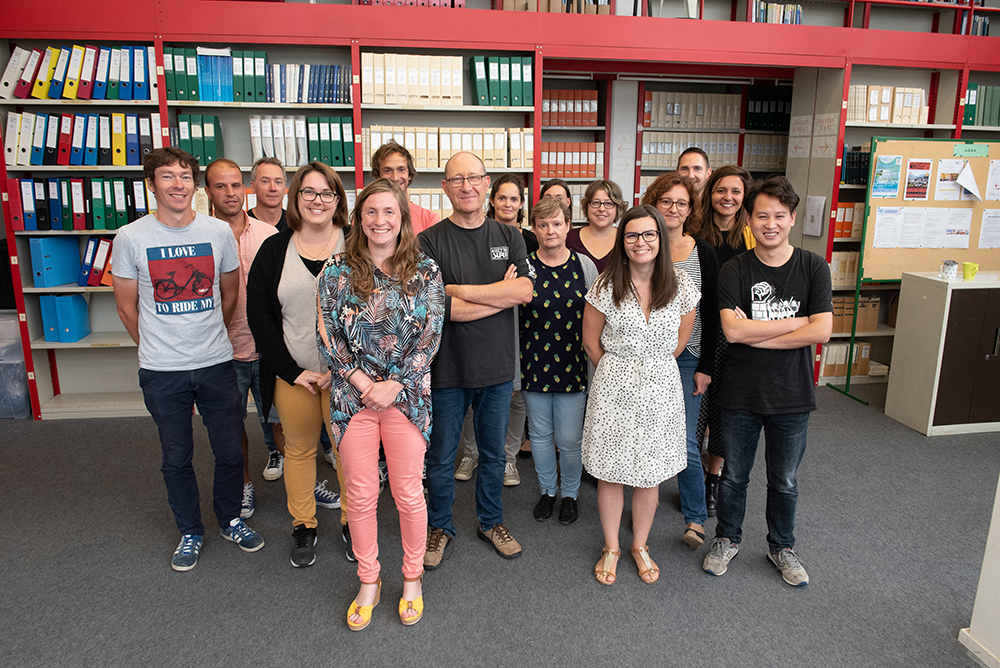
Reading time 8 min
Yann Guiguen, in an ocean of science
Published on 18 November 2019
“Fish have always been one of my passions.” As a kid, he had at least 10 aquariums and his focus was already on reproduction. So when his father was offered a position in Tahiti, he had no problem pulling up anchor to set sail there!
When he returned to mainland France, his passion for the sea took concrete form in his life as a student of zoology, physiology and even endocrinology, eventually leading to a doctorate degree in 1992.
Yann joined INRA the next year. As a research scientist, he worked on sex differentiation in fish, which provides a wide range of prospects in agronomic science, from helping aquaculture take advantage of the biological traits specific to one sex to optimizing genitor or wild population stocks.
Molecular biology was a rising star at the time, so Yann went to the US for a year to gain sound experience in that field.
Female or male from birth (…or not)
A whole series of major results emerged. Yann revealed the role that the synthesis of female steroid hormones, i.e. estrogens, plays in the differentiation of ovaries in fish, highlighting the key role of one enzyme, aromatase. He also was involved in some highly regarded publications and decisive encounters.
In salmonid species, their genetic sex is determined by the male at fertilization and their phenotypic sex by the hormonal system’s activity during embryonic development. Administering either male or female steroid hormones makes it possible to produce populations that are solely male or female.
Fish, a pool for learning
Yann Guiguen used this sexual inversion process to compare the genes expressed in about 300 embryonic gonads for each genetic sex. He identified one gene, sdY (sexually dimorphic on the Y), which is only expressed in male gonads and can only be found in the genomes of male fish. Strangely enough, this sex-determining gene is the result of the evolution of an ancestral gene involved in the immune response, irf9, which didn’t have any link to those genes identified in vertebrates up to that time known to serve key functions during sexual development.
Swimming in their ancestors' wake
That was 10 years ago. “We knew we were on the right trail,” he said, remembering the intellectual excitement during that period when he and his colleagues developed experiments to allow them to describe sdY’s function. Yann accomplished a real feat in demonstrating that sdY is not only required, but is, in and of itself, sufficient to induce and maintain male differentiation. He also showed that sdY plays a key role in sex determination in salmonids and is highly conserved in such species.
Yann still had some tricks up his sleeve! By interacting with the protein Foxl2, which regulates estrogen synthesis, the SdY protein blocks that process and so, the development of ovaries, thereby giving priority to male gonads.
Now this scientist, acclaimed for his international expertise in sex determination in vertebrates, particularly fish, has, in his characteristically low-key way, accepted INRA’s Scientific Breakthrough Award for his work. This honor commends a collective effort and so he wants to share it with all those involved.

55 ans, maried with three children
Career
Since 2016 Assistant Director, INRA Fish Physiology and Genomics Lab (LPGP), INRA’s Brittany-Normandy Research Centre
Since 2015 Head of the LPGP Sex, Oogenesis and Behavior Group
Since 2006 INRA Research Director
2004 Accredited to supervise research
Since 1999 INRA Coordinator of research into fish genomics
1993 INRA research officer
Education
1992 Doctoral thesis in Applied Basic and Biological Sciences; Univ. Rennes I, France
1988 Master in Biology and Agronomy, specializing in Animal Physiology; Univ. Rennes I and Rennes Higher Institute of Agricultural Sciences, France.
Distinctions
2019 INRA Scientific Breakthrough Award
Hobbies
Water sports: diving, surfing, sailing
What comes next ? |
|
Yann is already in the world of tomorrow. A team that has grown over the years with new colleagues, new projects, and yet, still the same passion for his focus on sex determinism in fish so as to better understand the molecular and functional evolution of these major sex determinants. There are still many questions to be answered. The genome in fish, which are generally categorized as bony, is characterized by full duplication, that is to say, it contains two copies of every gene. What has evolution done with all those genes? Eliminate them, give them new functions or even divide up the functions carried by their ancestral vesions? And what can be said about the extra chromosome in Central American cave fish that carries a major sex determinant? Yesterday, their names were Rainbow the Trout or Zou the Pike and their photos hung at the entrance to the lab. Today, it is piranhas, rays and Astyanax from the waters of French Guyana that fascinate Yann. A diversity that he recently had the chance to explore and which he would talk about at length if he had the time! |
|
Pan Q. et al. 2019. Identification of the master sex determining gene in Northern pike (Esox lucius) reveals restricted sex chromosome differentiation. PLoS Genetics 15: e1008013.
Sävilammi T. et al. 2019. The chromosome-level genome assembly of European grayling reveals aspects of a unique genome evolution process within salmonids. Genes, Genomes, Genetics 9: 1283.
Herpin A. et al. 2019. A novel evolutionary conserved mechanism of RNA stability regulates synexpression of primordial germ cell-specific genes prior to the sex-determination stage in medaka. PLoS Biology 17 : e3000185.
Du K. et al. 2019. The genome of the arapaima (Arapaima gigas) provides insights into gigantism, fast growth and chromosomal sex determination system. Scientific Reports 9: 5293.
Feron R. et al. 2019. Characterization of a Y-specific duplication/insertion of the anti-Mullerian hormone type II receptor gene based on a chromosome-scale genome assembly of yellow perch, Perca flavescens. BioRxiv 717397. |
|---|
